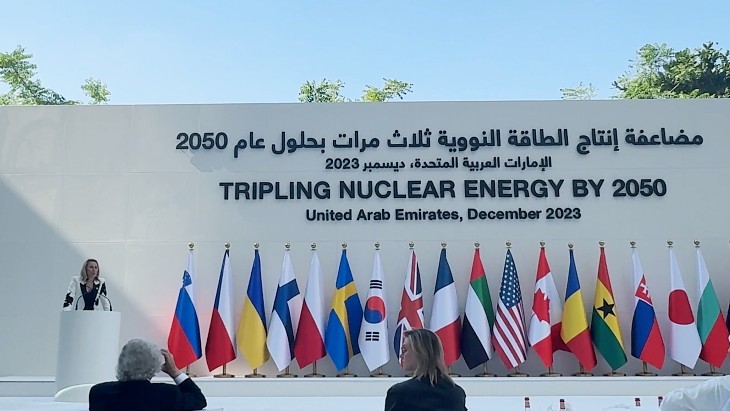Description

Disclaimer: Copyright infringement not intended.
Context
- 22 countries have pledged to triple the global nuclear installed capacity by 2050, at the COP28 climate meeting.
COP (Conference of the Parties)
- COP is the main decision-making body of the United Nations Framework Convention on Climate Change (UNFCCC).
- It includes representatives of all the countries that are signatories (or ‘Parties’) to the UNFCCC.
- COP assesses the effects of measures introduced by the Parties to limit climate change against the overall goal of the UNFCCC.
UNFCCC (United Nations Framework Convention on Climate Change)
- The UNFCCC is an agreement between 197 countries of the United Nations.
- The agreement is to “stabilise greenhouse gas concentrations at a level that would prevent dangerous anthropogenic (human-induced) interference with the climate system.
- The UNFCCC entered into force on 21 March 1994.
- The 197 countries that have ratified the Convention are called Parties to the Convention.
- The ultimate aim of the UNFCCC is to prevent “dangerous” human interference with the climate system.

How often does COP take place?
- COP happens every year unless otherwise agreed by the parties.
- Because of the COVID-19 pandemic, the 2020 COP was postponed until 2021.
- COP26 was hosted by the UK in Glasgow, from 1 to 12 November 2021, while Italy organised a range of pre-COP sessions and events in Milan.
- The UK continues to hold the COP26 presidency until COP27.
- COP27 took place from 7-18 November 2022 in Sharm El-Sheikh, Egypt.
What happens at COP?
- COP meetings primarily revolve around negotiations and debates.
- The aim is to review progress towards the overall goal of the UNFCCC: to limit climate change.
- Sometimes, COP will result in new agreements and treaties, often with the goal of refining targets, agreeing rules or forming binding treaties, like the Kyoto Protocol.
- A key part of COP meetings is to review the contributions of each of the Parties, detailing how they are tackling climate change. Members who are also party to the Paris Agreement will submit Nationally Determined Contributions (NDCs).
- These are plans by each country to reduce their emissions and adapt to the impacts of climate change. Taken together, these actions will determine whether we meet the goals of the Paris Agreement.
What is the Paris Agreement?
- The Paris Agreement is the first legally-binding global treaty on climate change agreed in COP21 in Paris in 2015.
- Since 2015, under the Paris Agreement, almost all countries in the world have committed to:
- Keep the rise in global average temperature to ‘well below’ 2°C, and ideally 1.5°C, above pre-industrial levels.
- Strengthen the ability to adapt to climate change and build resilience.
- Align finance flows with ‘a pathway towards low greenhouse gas emissions and climate-resilient development’.
- The Paris Agreement has a ‘bottom-up’ approach where countries individually decide by how much they will reduce their national emissions each year.
- They communicate these targets to the UNFCCC secretariat in the form of ‘nationally determined contributions’, or ‘NDCs’, which they have agreed to revise every five years.
- This five-year cycle of increasing ambition is known as the ‘ratchet mechanism’.
COP28
- Officially, COP 28 stands for the 28th meeting of the Conference of the Parties (COP) to the UNFCC.
COP 28: Pledge to triple nuclear generation capacity by 2050
- A pledge to triple nuclear generation capacity by 2050 from a base year of 2020 was signed Dec. 2 by 22 countries at the UN's Climate Change Conference in Dubai, including the US, Canada, Japan, France, the UK, and the UAE.
- The Declaration to Triple Nuclear Energy "recognizes the key role of nuclear energy in achieving global net-zero greenhouse gas emissions by 2050 and keeping the 1.5-degree goal within reach.
- Signatories have committed to supporting the development and construction of nuclear reactors, "such as small modular and other advanced reactors for power generation as well as wider industrial applications for decarbonization, such as for hydrogen or synthetic fuels production.
- Participating countries would encourage the World Bank and other international and regional development banks to include nuclear energy in energy lending policies.
- The declaration recognized the importance of extending lifetimes of existing reactors, and commits to support "responsible nations" looking to deploy new civil nuclear generation.
- Calling on other countries to join the declaration, participants said they would review progress on the agreement every year on the margins of COP meetings.
- Signatories include the US, Bulgaria, Canada, Czech Republic, Finland, France, Ghana, Hungary, Japan, Republic of Korea, Moldova, Mongolia, Morocco, Netherlands, Poland, Romania, Slovakia, Slovenia, Sweden, Ukraine, United Arab Emirates, and the UK.
Global Nuclear Output
- Global nuclear capacity totaled 375 GW in 2020, according to the International Atomic Energy Agency.
- Global nuclear output of 2,545 TWh in 2022 was 100 TWh down year on year, World Nuclear Association data show.
- The bulk of this decline related to outages caused by weld problems in ageing French reactors, while phase-outs in Germany and the war in Ukraine had further downside impacts on output.
- In contrast to Europe, nuclear electricity generation in Asia increased by 37 TWh last year.
- Over the last ten years nuclear generation in Asia has more than doubled and has now overtaken nuclear generation in West and Central Europe. Three-quarters of the reactors in construction globally are in Asia.
- Six new reactors were connected to the grid in 2022 – two in China, and one each in Finland, Pakistan, South Korea and the United Arab Emirates. Construction started on eight more - five in China, two in Egypt and one in Turkey.
- These additions are welcome, but a far faster rate of construction and commissioning will be needed, at least a tripling of nuclear capacity worldwide, to achieve net-zero greenhouse gas emissions by 2050.
Note: The UAE is the first Gulf country to produce nuclear power. The fourth reactor at the UAE’s Barakah power plant was licensed.
.jpg)
India and Nuclear Power
- India currently has 6,780 MW of installed nuclear capacity, and is constructing new reactors, which will add almost an equal amount – 6,800 MW, thereby doubling its capacity in the near future.
- In addition to its role in achieving nationwide electrification and increasing energy security, nuclear is a crucial part of India's clean energy policy. Currently, approximately 80% of the country's electricity comes from fossil fuels, which will need to decrease if India hopes to meet its ambitious climate goals.
- Nuclear power is a clean and environment-friendly base load source of electricity generation, which is available 24X7.
- It also has a huge potential and can provide the country with long-term energy security in a sustainable manner.
- Expansion of nuclear power capacity will help in the country’s energy transition for meeting the goal of net zero economy.
READ ABOUT NUCLEAR POWER IN INDIA:
https://www.iasgyan.in/daily-current-affairs/nuclear-power-in-india
https://www.iasgyan.in/daily-current-affairs/nuclear-power-30
READ ABOUT NET ZERO: https://www.iasgyan.in/daily-current-affairs/net-zero-target
|
PRACTICE QUESTION
Q. In addition to its role in achieving nationwide electrification and increasing energy security, nuclear energy is a crucial part of India's clean energy policy. Justify.
|












